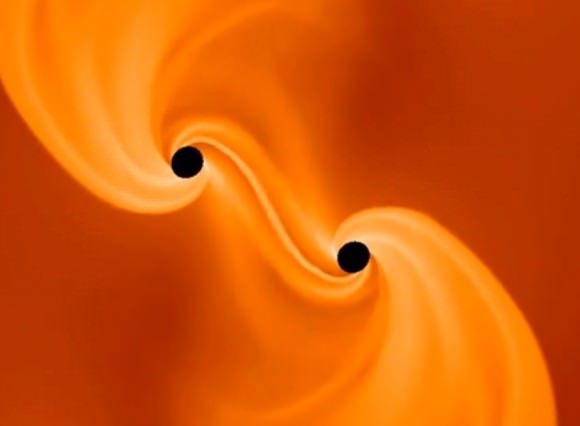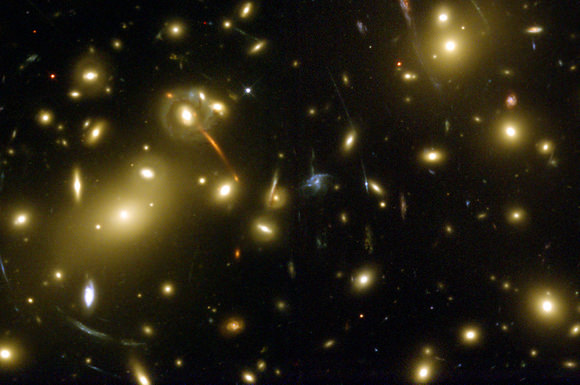Quantum physics is a fascinating yet complicated subject to understand, and one of the things that freaks out physics students every is the concept of entanglement. That occurs when physicists attempt to measure the state of a particle and that affects the state of another particle instantly. (In reality, the particles are in multiple states — spinning in multiple directions, for example — and can only be said to be in one state or another when they are measured.)
“Spooky action at a distance” is how Albert Einstein reportedly referred to it. Here’s the new bit about this: Julian Sonner, a senior postdoctoral researcher at the Massachusetts Institute of Technology, led research showing that when two of these quarks are created, string theory creates a wormhole linking the quarks.
According to MIT, this could help researchers better understand the link between gravity (which takes place on a large scale) to quantum mechanics (which takes place on a very tiny scale). As MIT puts it, up to now it’s been very hard for physicists to “explain gravity in quantum-mechanical terms”, giving rise to a preoccupation of coming up with a single unifying theory for the universe. No luck yet, but many people believe it exists.

“There are some hard questions of quantum gravity we still don’t understand, and we’ve been banging our heads against these problems for a long time,” Sonner stated. “We need to find the right inroads to understanding these questions.”
Quantum entanglement sounds so foreign to our experience because it appears to exceed the speed of light, which violates Einstein’s general relativity. (The speed limit is still being tested, of course, which is why scientists were so excited when it appeared particles were moving faster than light in a 2011 experiment that was later debunked due to a faulty sensor.)
Anyway, this is how the new research proceeded:
– Sonner examined the work of Juan Maldacena of the Institute for Advanced Study and Leonard Susskind of Stanford University. The physicists were looking at how entangled black holes would behave. “When the black holes were entangled, then pulled apart, the theorists found that what emerged was a wormhole — a tunnel through space-time that is thought to be held together by gravity. The idea seemed to suggest that, in the case of wormholes, gravity emerges from the more fundamental phenomenon of entangled black holes,” MIT stated.

– Sonner then set about to create quarks to see if he could watch what happens when two are entangled with each other. Using an electric field, he was able to catch pairs of particles coming out of a vacuum environment with a few “transient” particles in it.
– Once he caught the particles, he mapped them in terms of space-time (four-dimensional space). Note: gravity is believed to be the fifth dimension because it can bend space-time, as you can see in these images of galaxies below.
– Sonner then tried to figure out what would happen in the fifth dimension when quarks were entangled in the fourth dimension, using a string theory concept called holographic duality. “While a hologram is a two-dimensional object, it contains all the information necessary to represent a three-dimensional view. Essentially, holographic duality is a way to derive a more complex dimension from the next lowest dimension,” MIT stated.

– And it was under holographic duality that Sonner found a wormhole would be created. The implication is that gravity itself may come out of entanglement of these particles, and that the bending we see in the universe would also be due to the entanglement.
“It’s the most basic representation yet that we have where entanglement gives rise to some sort of geometry,” Sonner stated. “What happens if some of this entanglement is lost, and what happens to the geometry? There are many roads that can be pursued, and in that sense, this work can turn out to be very helpful.”
You can view the research in Physical Review Letters.


This is interesting. Black holes have often been thought of to be equivalent to quantum particles because precisely the same amount of limited information can be known for both. That’s apparently why black hole entanglement can be compared (successfully?) to quantum entanglement.
Holographic duality sounds deliciously intriguing. Nice review.
Very interesting stuff here. If it turns out that entanglements create gravity, then could there be a possibility of creating artificial gravity?
Interesting idea. I can’t remember the source, but I recall reading that if wormholes could be created and stabilized, they might be enlarged enough to allow probe or even human travel through them.
I wondered whether communication through them might be possible – imagine realtime control of say Martian rovers, with realtime audio and video. I believe that currently entanglements have been created that lasted for under an hour but that longer periods are on the horizon.
I never understand those who claim science is boring… 🙂
Now.. if every particle of matter contains a quantum scale black hole, then…. YIKES! http://phys.org/news161857121.html
Minor nit? “…that freaks out physics students every is the concept of…” S/B(?) “…that freaks out physics students everywhere is the concept of….”
An extraordinarily difficult subject to grasp, let alone explain. A good effort, Elizabeth. We’ve often tried to describe gravity as emergent phenomena, perhaps as entanglement left over from the state of all things prior to the Big Bang, when all things may have become (and might still be) entangled. One thorny problem we’ve encountered is the inverse-square law, when determining a body’s influence. A worm-hole, in the mathematics, would seem to imply an influence over zero distance, and gravity, as we know, doesn’t seem to behave that way.
Regardless, thank you for trying to explain a subject most writers simply never attempt for fear of making the average reader’s head explode.
Lawrence Crowell, where are you? I miss your comments on subjects like this.
When they introduced g+ on this site, alle the good commentators left..
The same thing is happening now on Youtube.
They forced everyone to use Google+ and destroyed the commenting section. Most content creators I followed stopped creating since they cannot interact with their people any-more.
I really wish that any science site (UT, NASA) …stops using Google+ hangouts since it locks out a lot of people that have absolutely no interest in Google+.
I miss LC as well, not sure where he’s gone…
One thing that freaks out English students is this sentence:
“Quantum physics is a fascinating yet complicated subject to understand, and one of the things that freaks out physics students every is the concept of entanglement.”
Every?
iv often wondered about the speed of gravity. Gravitys apparant speed is infinite as we sense no delay between the suns current position and its gravitational field similar to the delay of sun light.
If there was a delay then the solar orbits get messed up. Even Newton was unhappy with the instantaneous speed of gravity but that is what the numbers and NASA lead us.
I remember reading about this. The speed of gravity was found to be the same as the speed of light. There is no reason for a delay with the sun, the gravitational field of the sun is quite uniform in time. The paper I read was about measuring gravitational interactions from outer planets in specific circumstances. Basically, you need an interferometer to measure gravitational waves, and an event that you can both watch (reaching you at the speed of light) and measure this way.
Wormholes and strings… sigh… I guess it is a good way to eliminate the possibilities.